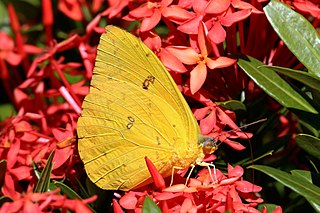
Phoebis sennae, the cloudless sulphur, is a mid-sized butterfly in the family Pieridae found in the Americas. There are several similar species such as the clouded sulphur, the yellow angled-sulphur, which has angled wings, the statira sulphur, and other sulphurs, which are much smaller. The species name comes from the genus Senna to which many of the larval host plants belong.
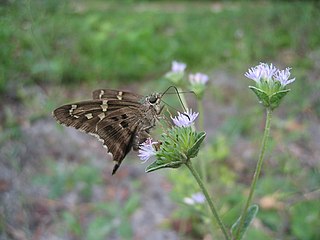
The long-tailed skipper is a spread-winged skipper butterfly found throughout tropical and subtropical South America, south to Argentina and north into the eastern United States and southern Ontario. It cannot live in areas with prolonged frost. It is a showy butterfly, with wings of light brown tinted with iridescent blue, and two long tails extending from the hindwings. The robust body is light blue dorsally. It has a large head, prominent eyes, and a wingspan between 4.5 and 6 centimeters.
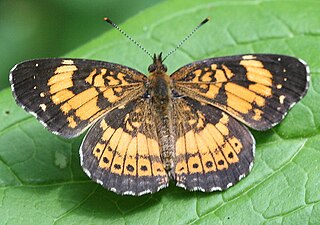
Chlosyne nycteis, the silvery checkerspot, is a species of Nymphalinae butterfly that occurs in North America. It is listed as a species of special concern in Connecticut and Maine, and is believed extirpated in Connecticut, Massachusetts, and New Hampshire.
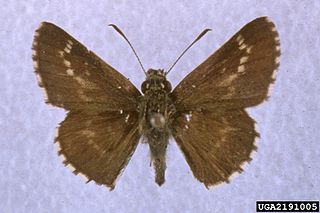
Amblyscirtes aesculapius is a butterfly of the family Hesperiidae. It is found from eastern Oklahoma and eastern Texas, east to south-east Virginia, south along the Atlantic Coast to northern Florida.
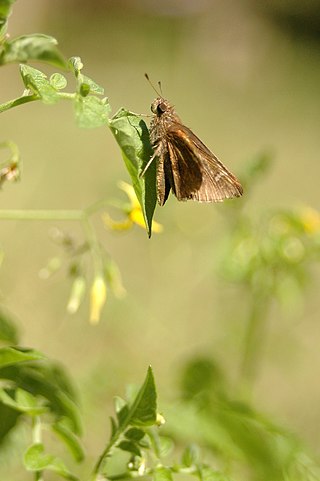
Lerema accius, the clouded skipper, is a butterfly of the family Hesperiidae. It is found in the United States from Georgia west to Texas, south to Florida, and south through Mexico and Central America to Venezuela and Colombia.

Lerodea eufala, the Eufala skipper or rice leaffolder, is a species of butterfly in the family Hesperiidae. It is found from the coast of Georgia, south through Florida and west across the southern United States to southern California, south through Mexico and Central America to Patagonia. In the summer, it expands its range north to central California, North Dakota, southern Wisconsin, northern Michigan and Washington, D.C.

Calpodes ethlius, the Brazilian skipper, larger canna leafroller or canna skipper, is a butterfly of the family Hesperiidae. It is found in the United States from southern Florida and southern Texas, south through the West Indies, Mexico, and Central America to Argentina. Strays and temporary colonies can be found north to southern Nevada, northern Texas, Illinois and Massachusetts.

Wallengrenia egeremet, the northern broken dash , is a butterfly of the family Hesperiidae. It is found in North America from southern Maine and southern Ontario, west across the Great Lakes states to southeastern North Dakota, south to central Florida, the Gulf Coast and south-eastern Texas.

Pholisora catullus, the common sootywing or roadside rambler, is a butterfly of the family Hesperiidae. It is found from the central parts of the United States, south to central Mexico. Strays may colonize up to southern British Columbia, northern Michigan, southern Quebec and southern Maine. It is not found on peninsular Florida.

Hesperia metea, the cobweb skipper, is a butterfly of the family Hesperiidae. It has a scattered distribution in the United States from southern Maine west to Wisconsin, south to central Georgia, the Gulf States and central Texas.

Staphylus is a genus of skippers in the family Hesperiidae found mainly in South America with some species in the Caribbean, Mexico, Central America, and southern United States.
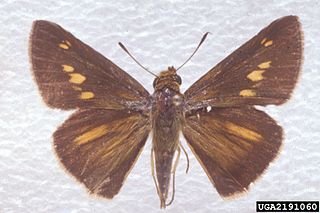
Euphyes dion, the Dion skipper or Alabama skipper, is a species of butterfly of the family Hesperiidae. It is found in scattered populations along the Atlantic coast of North America, from western Massachusetts and south-eastern New York south to north-eastern Florida, west to north-eastern Texas, and north to south-eastern North Dakota, northern Wisconsin, southern Ontario and southern Quebec. It is listed as a species of special concern in the US state of Connecticut.

Vernia verna, the little glassywing, is a species of butterfly of the family Hesperiidae. It is found in the eastern United States and southeastern Canada, from central New England west to central Nebraska, south to northern Florida, the Gulf Coast and southern Texas.

Echinargus isola, or Reakirt's blue, is a butterfly of the family Lycaenidae. It is the sole representative of the monotypic genus Echinargus. It is found in Central America and the extreme southern U.S. Echinargus isola migrates regularly throughout most of the U.S. almost to the Canada–United States border, and very rarely into the southern prairies.

Staphylus ceos, the golden-headed scallopwing, is a species of spread-wing skipper in the butterfly family Hesperiidae. It is found in Central America and North America.

Satyrium caryaevorus, the hickory hairstreak, is a butterfly of the family Lycaenidae. It is found in eastern North America, from southern Ontario west to Minnesota and Iowa, south in the Appalachian Mountains to eastern Tennessee.

Staphylus mazans, the mazans scallopwing, is a species of spread-wing skipper in the butterfly family Hesperiidae. It is found in Central America and North America.


















